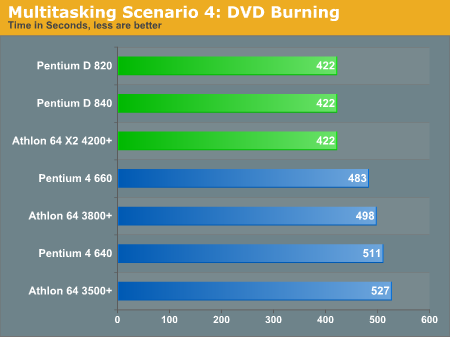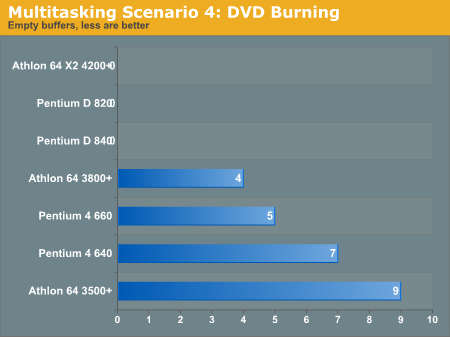Dual Core Linux Performance: Two Penguins are Better than One
by Kristopher Kubicki on July 1, 2005 5:55 AM EST- Posted in
- Linux
Multitasking Scenario 4: DVD Burning
Thanks to NeroLINUX, we can now run the first benchmark we did in reverse. We will be paying particular attention to the buffer for NeroLINUX. If the burn continually empties the buffer, then the system is playing catch-up to the burner. We will count the number of times the buffer dies and graph this separately. We used a NEC 3520A burner and a 4.5GB ISO image for the burn.
- Open FireFox 1.0.4 and load all 5 web pages.
- Open XMMS and start playing a Nine Inch Nails CD ripped to Ogg
- Open Thunderbird for news
- Login to our news server and start downloading headers for our subscribed news groups
- Begin an ISO burn with NeroLINUX and start timing


There seems to be a very linear correlation between the number of buffer dumps and the speed at which the discs burned. We really only saw the buffer even come in danger of decreasing at the beginning of the burn and when Thunderbird took a little too long to process something coming in from the news server.
Even though the processors we used in this analysis are more than capable, the additional tasks of FireFox and Thunderbird proved just a tad too much for the chips to handle at all once. This benchmark is a great illustration of where dual core (or dual socket) goes so wonderfully well on the desktop. The additional overhead to run XMMS, FireFox and the other applications is not very substantial, but when FireFox decides to chew up resources while the only CPU is managing the write buffer on a DVD burn, the results can be quite dramatic.










69 Comments
View All Comments
StealthyOne - Friday, July 1, 2005 - link
where is the pentium EE? :-)JGunther - Friday, July 1, 2005 - link
#4, it's 'cause Kris is writing the article. 'nuff said. ONCE AGAIN he's skewed the benchmarks by throwing the top of the line Intel dual core chip up against the entry level AMD chip. Nice job.Also, ditto on #7 and #12... way to criticize the AMD part for its price, Kris, without mentioning that the Pentium-D requires a mobo upgrade while the X2 does not.
semo - Friday, July 1, 2005 - link
#6 that's what i'm thinking.plus, i thought that with dma enabled, the cpu would not have to do too much work to burn a dvd
atlr - Friday, July 1, 2005 - link
I look forward to some database server/web server tests.appu - Friday, July 1, 2005 - link
Kris, great work! You might want to consideramaroK (http://amarok.kde.org) as an equivalent
of iTunes under Linux, or even gtkpod. XMMS is
better treated as an equivalent of Winamp 2.x.
Furen - Friday, July 1, 2005 - link
I have one question: why was the compile job on the x2 system only run with -j1? Not trying to flame you or anything, just a wondering...bob661 - Friday, July 1, 2005 - link
Kristopher Kubick,"At $558 you pay through the nose for the additional performance of the Athlon 64 X2 4200+"
That's the price for the P-D 840 not the X2 4200.
SLIM - Friday, July 1, 2005 - link
I think #7 has hit the nail on the head. One other large difference in the prices besides the memory is the extra $100+ spent on a 955x motherboard or a comparable nforce4 sli intel edition (not sure if these support dual core yet though). The price difference, as has been pointed out several time before, between the intel cpus and amd cpus is just about negated once you tack on the extra cost of the MB and memory.You could definitely choose a 945 MB and save about $100 but I have yet to see the pentium D benched on that platform, and I don't think there is an sli platform for intel that's available for under $225.
GoatHerderEd - Friday, July 1, 2005 - link
Ill stick with my K6-3 550 (=Furen - Friday, July 1, 2005 - link
haha, what a cool article name and icon =)